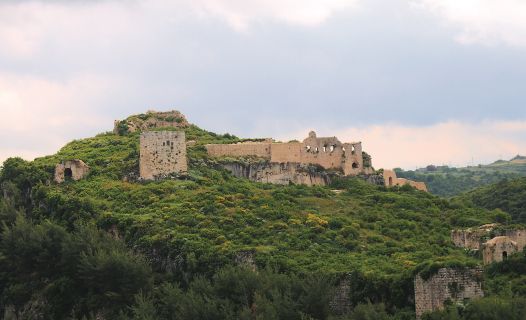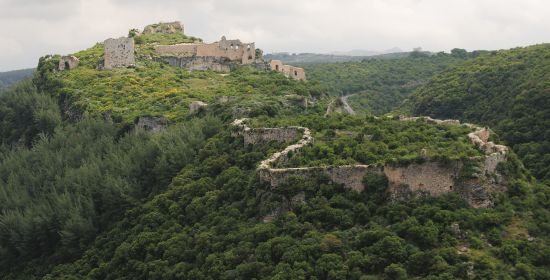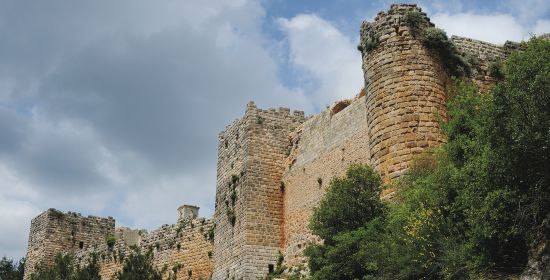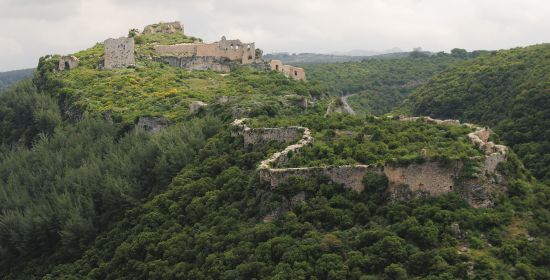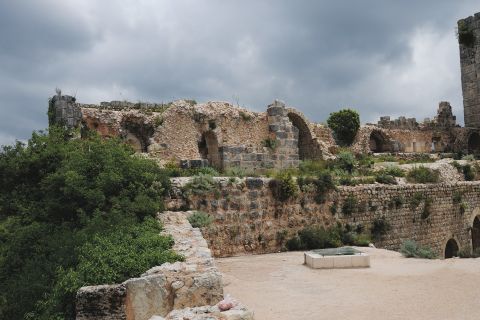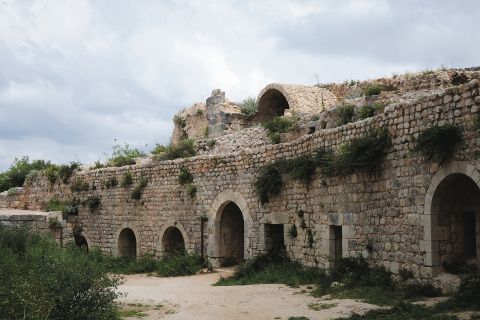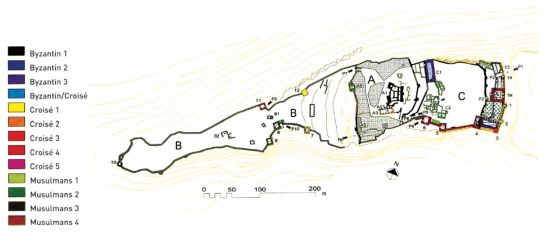The Castle of Salahaddin
Syria Latakia 11,12,13th Century
Byzantine, Seijuk, Crusader, Ayyubid, Mamluk
Many castles were built in Syria in the Middle Ages, and some are located on important caravan routes. The most remarkable of these castles which existed before the Seljuks came to this region is the settlement known as the Castle of Salahaddin. The castle is also called Sahyun castle, which means "Zion" in Arabic.
The castle is surrounded by a natural valley on one side and a deep ditch on the other. There is a passage to a gate, made by the lifting up of a natural rock foot on the east side of this ditch.
The castle, with a triangular shape, was constructed on a rocky area. Entrance to the castle is through a gate, defended by two towers, in the southern facade. In order to strengthen the defense of the castle, the castle consists of two sections.
There is an elevated section in the east, which constitutes the center of the castle. The cisterns, storehouse and stables are found here. The castle has another gate ton the east This gate, which is reached after passing over the ditch by a drawbridge, is impressive. Most of the parts here were built during the Byzantine period. However, it is known that many parts were constructed in the Islamic period as well, especially in the eastern section.
The section with a dungeon comprises the central and oldest part of the castle. The Castle walls ta the east of this section are fortified with numerous semi-circular and rectangular towers. The second section, which is in the western part of the castle, was separated at a later date by a castle wall from the eastern section. The castle walls, which follow the rim of the valley ta the west of the castle, are long and thin. it is known that the ditch ta the east and south of the castle, almost 30 m in depth, was dug by the Crusaders. it is believed that only the eastern part of the castle existed when the Seljuks came ta the region and that the western parts were built mostly in the Ayyubid period. The palace inside the castle was constructed using the Aleppo Citadel palace as a model. The designs used in this part of the castle are different than the architectural style of Syria, and is due ta the the fact that the Crusaders designed the castle according ta their own tastes.
The early castle, which was built during the Byzantine and the Crusader periods, was further developed by the Ayyubids. Two baths and a small mosque were built around the Ayyubid palace. This section was turned into a separate section in the castle when the Mamluks constructed a wall ta the west
Extensive research has been conducted about the castle. Syrian and French archaeologists confirmed, through excavations carried out in 2001 and 2002, that the section ta the east of the baths was built in the 13th century. An inscription, belonging ta the Mamluk period, was also found on the small mosque here.
The construction date of the castle is uncertain. It is known that the settlement was occupied by the Byzantines in the 11 th century. The castle held an important role far maintaining the security of the road, which, in the Byzantine period, went all the way ta Antakya. When the Seljuks came ta the region, the Castle of Salahaddin came under their control along with Antakya. The castle was captured by the Crusaders in 1114. Salahaddin Ayyubi recaptured the castle after laying siege far three days. It is known that the castle was invaded and destroyed by the Mongols in the middle of the 13th Century. The Mamluk Sultan Baybars retook the castle from the Mongols and rebuilt it. The Sultan Sungu alAshkar turned the castle into a garrison in the Mamluk period.
BİBLİYOGRAFYA: Beddek, K., "Le complexe ayyoubide de la citadelle de Salah al-Oin: bain ou palais?'', Archeologie lslamique, 11, 2001, s. 75-90.
Deschamps, P., "Le chateau de Saône et ses premiers seigneurs", Syria, XVI, 1935, s.71--88.
Deschamps, P., Les chateaux des Croises en Terre Sainte. Tome 111- La delense du comte de Tripoli et de la principaute d'Antioche, 2 Vals, Bibliotheque Archeologique et Historique, IFAPO, 105, Paris, 1973, s.217-47.
Kennedy, H., Crusader Castles, Cambridge, 1994, s.84-97.
Müller-Wiener, W., Castles of the Crusaders, Landon, 1966, s.44-45.
Rey, E-G., Etude sur les monuments de l'architecture militaire des Croises en Syrie et dans l'ile de Chypre, Paris, 1871, s.105-113.
Saade, G., "Histoire du chateau de Saladin", Studii Medievali, Vol IX, Part 2, 1968, s.980-1016.
Van Berchem, M., and Fatio, E., 'Voyage en Syrie", Vol. 1, Memoires de l'lnsbtut Français d'Archeologie Orientale du Caire, Cairo, 1914-15, s.267-283.
http/ /www.discoııerislamicart.org/database3em.phpd=monument;ISL;sı;Mon0l ;24;en&cp (Erişim Ekim 2012)

